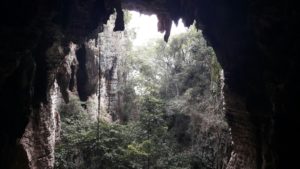Battambang is one of the less busy, and less touristic cities in Cambodia. You still have a lot to see – from the bats at Phnom Sampeau to the Bamboo train. If you want to avoid large tourist crowds, take a stop over in Battambang!
Travelling from Siem Reap to Battambang
According to TripAdvisor, the best way to travel from Siem Reap to Battambang is by boat. You can see a lot of fascinating countryside and small villages along the river banks and thus turn 5 five hours of travel into an interesting experience. However, this only applies to the time between March and December, when the water levels are high enough for a safe passage. In the dry season, you should expect running on sand banks, needing to get off the boat and cramming into small pickup trucks for hours under the hot sun.
Since we were travelling in early February, we took the bus from Siem Reap to Battambang instead. There are a lot of different bus options, with a strong correlation between the price for the ticket and the comfort level of the bus. The cheapest option we found was $6 per person and was mainly used by locals.
Day 1: Phnom Sampeau, Bats, and Battambang Killing Caves
After checking in at our hotel at 3:30 PM, we took a Tuk-Tuk (should be 8-12$) to Phnom Sampeau, which is approximately 20km south-west of the city. Our first destination at the hilltop were the Killing Caves. Visiting the killing caves is a chilling experience. It displays the fractured skulls of some of the victims of the Khmer Rouge, who killed hundreds of people at Phnom Sampeau by pushing them off the steep cliffs, or by bludgeoning them to death and disposing the bodies in the caves.
Our next stop, just some 100m further, was the colourful temple at the top of the mountain. It’s nothing spectacular, but it does provide a nice overview over the surrounding scenery. The temple is also home to a large group of monkeys who will steal your food if you’re not careful.
Directly below the temple is another, massive cave: the Nature Cave. Follow a steep stairway down and let the scenery work on you for a couple of minutes. Pro tip: Directly left of the stairs is a small grotto with a golden Buddha statue inside.
We then hurried down a steep stairway in order to be back in time for the most fascinating nature experiences of our entire trip: At 6:20 PM, hundred-thousands of bats are flying out of the Bat Cave to swarm around the mountain (and hopefully eat a lot of nasty mosquitos). You can comfortably sit in one of the chairs opposite of the Bat Cave and sip a beer ($1) while you wait for the first bats to fly out. Don’t worry whether you have picked the perfect viewpoint: The spectacle takes around 45 minutes, so you have plenty of time to walk around and look at the bats.
Day 2: Guided Tours around Battambang
Several tour guides offer guided tours in Battambang: Bun and Savet ($25 p.p.) already accumulated over 200 TripAdvisor reviews and Sam is taking you around by bike. We stayed with our driver from the day before, Mr. Blue. His tour just costs $12-15 per group (half day, $25 for a full day) and provides a much better value-for-money than the other tour operators.
You can tailor the tour to your own preferences, though the general theme usually stays the same: You drive around to several artisan shops and learn more about the daily life of the locals. We learned how Bamboo Rice, Sweet Coconut Pie and Rice Paper (for spring rolls) are produced, visited a temple and the Battambang Killing Fields – where the Khmer Rouge killed another 10,008 people – and a crocodile farm. Mr. Blue explained everything we saw on the way and gave us detailed insights into Cambodian history, religion and local production chains.
We also took a ride on the Bamboo Train. The Bamboo Train is a small, improvised carriage which rides along the old rail tracks. In earlier days, the locals used bamboo sticks to push the train forward and to transport goods from Thailand or Phnom Penh to Battambang. Then, in the early 2000’s, someone was able to purchase some engines in Thailand, and the bamboo sticks became history.
In the early morning, the route is still used for transporting goods. Throughout the day, it’s more lucrative to use the Bamboo wagons as a tourist attraction. We enjoyed the 20-minute ride through rice fields and local villages, but didn’t think the experience is worth the $5 a person.
Apparently, the old tracks are currently being renewed to allow a modern train connection between Battambang and Phnom Penh, so the days of the Bamboo Train are probably numbered anyway.
After the tour, we spent the rest of the day at the rooftop pool at Seng Hout Hotel to get some energy for our journey to Phnom Penh.
Our Travel Route for the Entire Trip
If you want to check out what else we experienced in South East Asia, check out our route of the entire trip – including more reviews of the most exciting places!
Travelling South East Asia in Two Weeks










